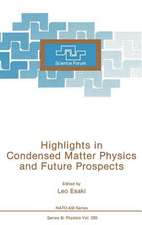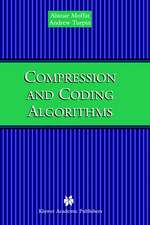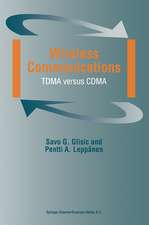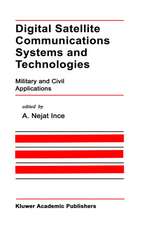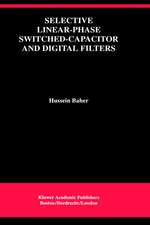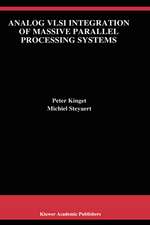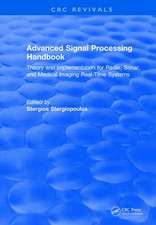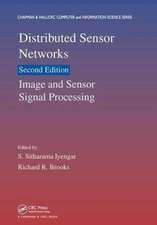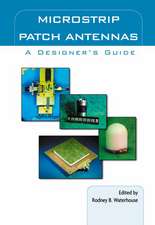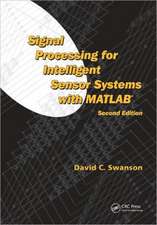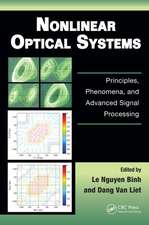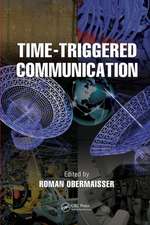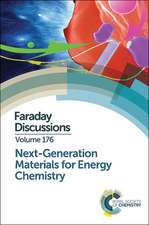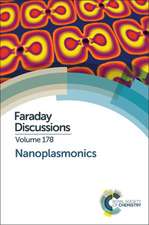Cathode Processes in the Mercury Arc
Autor I. G. Kesaeven Limba Engleză Paperback – 17 mar 2012
Preț: 642.83 lei
Preț vechi: 756.27 lei
-15% Nou
Puncte Express: 964
Preț estimativ în valută:
123.02€ • 133.58$ • 103.34£
123.02€ • 133.58$ • 103.34£
Carte tipărită la comandă
Livrare economică 22 aprilie-06 mai
Preluare comenzi: 021 569.72.76
Specificații
ISBN-13: 9781468415537
ISBN-10: 1468415530
Pagini: 364
Ilustrații: XVIII, 346 p.
Dimensiuni: 152 x 229 x 19 mm
Greutate: 0.49 kg
Ediția:Softcover reprint of the original 1st ed. 1964
Editura: Springer Us
Colecția Springer
Locul publicării:New York, NY, United States
ISBN-10: 1468415530
Pagini: 364
Ilustrații: XVIII, 346 p.
Dimensiuni: 152 x 229 x 19 mm
Greutate: 0.49 kg
Ediția:Softcover reprint of the original 1st ed. 1964
Editura: Springer Us
Colecția Springer
Locul publicării:New York, NY, United States
Public țintă
ResearchDescriere
Although the electric arc is perhaps the oldest field in elec tronics, it is still one of the least well understood. The beautiful and complex phenomena accompanying the conduction of electricity in gases have led to the development of spectroscopy (and thus of atomic structure and quantum theory), discovery of isotopes, of the electron itself, of X-rays and thus to Moseley's discovery of atomic number, to the discovery of electron emission, and thus to modern electronic technology as well as to much of modern physics. The properties of the plasma state of matter, which until relatively recently could be produced only by the passage of electricity through a gas, have helped explain many natural phenomena ranging from lightning, the aurora, and the ionosphere to solar, stellar, and mushroom-cloud physics. Many plasma devices, such as neon signs, sodium and mercury lamps, thyratrons, ignitrons, and mer cury pool rectifiers, have been with us for decades, and more are still being invented. To name but a few recent ones, we have plasma torches, plasma propulsion devices for space flight, and magnetohydrodynamic generators. Solving the problem of contain ing a high -energy plasma would lead to controlled energy generation by nuclear fusion. Plasma physics is thus more vigorous than ever in spite of its venerable old age. Kesaev's book is concerned in its entirety with one of the least satisfactorily understood aspects of the relation of a plasma to the electrodes bounding and maintaining it.
Cuprins
1. The Present State of Knowledge of the Cold Arc.- 1. General Description of the Arc Discharge.- A. Properties of the Cathode Spot on Mercury and Other Metals.- 2. Extent of the Cathode Parts of the Arc.- 3. Dimensions of the Emitting Surface and the Current Density at the Cathode.- 4. Magnitude of the Cathode Drop UC.- 5. Radiation from the Cathode Region of the Arc.- 6. Evaporation and Atomization of Mercury from the Cathode-Spot Region.- 7. Forces Acting in the Cathode Region of the Arc.- 8. Electrode Erosion in Arc and Spark Discharges.- 9. Division of the Cathode Spot.- 10. Motion of Cathode Spot.- a. Random Motion.- b. Directed Motion.- 11. Anchoring of the Cathode Spot.- 12. Conditions Under Which an Arc Occurs.- a. Exciting an Arc by Bringing Contacts Together.- b. Exciting an Arc by Breaking the Circuit.- c. Breakdown of Gaps in Gas or Vacuum.- d. Transition from a Glow Discharge to an Arc. Transition from a Thermionic Arc to a Cold Arc.- e. Other Methods of Exciting an Arc.- 13. Conditions for Arc Decay.- a. Extinction of Arc from Reduction or Change in Polarity of Current.- b. Other Types of Arc Extinction.- B. Development of Ideas on the Arc-Discharge Mechanism.- 14. The Thermionic Theory of the Arc and Its Associated Difficulties.- 15. Cold-Emission Theory of the Arc.- 16. Slepian’s Thermal Theory.- 17. Further Development of Ideas on the Mechanism of the Cold-Cathode Arc.- C. The Most Probable Mechanism for the Cold-Cathode Arc. Additional Methods of Investigation.- 18. The Energy Balance at the Cathode as a Criterion for the Correctness of Theory.- 19. The Current Density in the Cathode Spot and Its Importance in the Cold-Arc Problem.- 20. Conclusion.- 2. The Stability of the Mercury Cathode Arc.- 21. Statement of the Problem.- A. Statistical Study of Spontaneous Arc Extinction.- 22. Method of Observation and Apparatus.- 23. Methodological Notes.- 24. The Mean Arc Duration ? as Effected by External Circuit Parameters.- a. Variation of ? with Current and Voltage.- b. Effect of Circuit Inductance.- c. Effect of Capacity.- 25. Mean Arc Duration ? as Affected by Conditions Inside the Discharge.- a. Effect of Arc Length and Cleanness of Mercury Surface on the Arc Duration ?.- b. Effect of Temperature and State of Aggregation of the Cathode on ? Results of Measurements on an Arc with an Anchored Spot.- c. Effect of a Gaseous Medium on the Stability of the Arc.- d. Stabilizing Effect of a Magnetic Field.- e. Effect of the Method of Exciting the Arc.- 26. Discussion of the Results of Measurements.- B. Oscillational Process in the Cathode Region and the Restoring Mechanism of the Arc.- 27. Voltage Oscillations in the Short Arc.- a. Method of Observation.- b. Oscillations in an Arc with an Anchored Spot.- c. Oscillation Processes in an Arc with the Cathode Spot Moving Freely Over the Mercury.- 28. The Transitional Form of the Arc Discharge.- 29. The Relation Between the Voltage Oscillations and the Cathode Processes in a Short Arc. Instability of the Cathode Drop.- 30. Arc Re-ignition and “Relay-Race” Types of Arc Restoration.- C. The Problem of Arc Stability and How It is Affected by Various Internal Factors.- 31. Physical Features of Possible Ways of Stabilizing the Arc.- a. Mechanism of Arc Stabilization by Cathode Heating.- b. The Nature of the Phenomena Occurring in a Solid-Cathode Arc.- c. The Increase in Arc Stability When the Cathode Spot is Anchored on a Thin Liquid Mercury Film.- d. The Mechanism by Which a Gaseous Medium Affects the Arc.- e. The Mechanism by Which the Arc is Stabilized by a Magnetic Field.- 32. Internal Instability of the Mercury Cathode Arc.- 3. The Focal Structure and the Continuous Decay and Re-formation of the Cathode Spot on a Mercury Cathode.- 33. Fundamental Problems and Methods of Investigating the Cathode Spot.- A. Structure and Behavior of the Cathode Spot on Mercury Under Steady-State Current Conditions.- 34. Investigation of the Structure of the Spot Where It is Anchored at the Boundary of the Region Where a Metal is Wet by Mercury.- 35. Data on the Elementary Cells in the Cathode Spot.- 36. Decay and Division of Elementary Cathode-Spot Cells Under Steady-State Conditions.- 37. Interaction Between Cells and Why They Move Over the Cathode.- 38. Coordination Between Cell Decay and Cell Division. The “Relay-Race” Type of Arc Restoration.- 39. Special Features of the Structure of the Cathode Spot on a Homogeneous Liquid Cathode.- B. How an Arc Discharge is Set Up, and How It Changes from One Steady State to Another.- 40. Setting Up the Steady State of the Arc at a Rate of Current Increase Less Than 108A/sec.- 41. Nature of the Phenomena When the Current Is Increased at a Rate of 108 A/sec or Higher. Transition to a Spark Discharge.- 42. The Essence of the Process Controlling the Current in the Cold-Cathode Arc. The Dynamic Volt-Ampere Characteristic of the Arc.- C. Re-formation of the Cathode Spot in the Steady State and the Role Played in the Process by a Magnetic Field.- 43. General Information on Spot Re-formation on a Cold Cathode.- 44. Model of the Cathode Spot on a Homogeneous Liquid Mercury Cathode.- a. Structure and Fundamental Physical Processes of the Spot.- b. Factors Determining the Stability and Dimensions of the Spot. Effect of the Inherent Magnetic Field of the Arc.- c. Excess Electrons in the Ionization Region of the Arc. Electron Envelope of the Cathode Spot.- d. Simplified Dynamic Model of the Cathode Spot.- 45. The Dominant Role Played by the Magnetic Field in Regular Cathode-Spot Re-formation. The Maximum Field Principle.- 4. Basic Forms of Cathode-Spot Re-formation on a Homogeneous Liquid Cathode.- 46. Problems and Importance of Investigating the Motion of the Spot. Need to Include the Effect of the Inherent Magnetic Field of the Arc.- A. Regular Motion of the Cathode Spot on a Liquid Mercury Cathode.- 47. Direction of the Motion.- a. Theoretical Trajectory of the Spot in an Inhomogeneous Magnetic Field.- b. Experimental Study of the Trajectory of the Cathode Spot in an Inhomogeneous Magnetic Field.- c. The Trajectory of the Cathode Spot as Affected by the Slope of the Magnetic Field Vector Relative to the Cathode.- 48. Rate of Motion of the Spot and New Ways of Finding the Current Density at the Cathode of the Arc.- a. Theoretical Discussion of the Question. Limits of Applicability of the Theory.- b. Results of Measuring the Rate of Motion of the Spot as a Function of the Magnetic Field Intensity and Current.- c. Rate of Motion of the Spot in a Magnetic Field as a Function of the Density of the Gas Medium, and the Motion Inversion Phenomenon.- B. Division of the Cathode Spot and Interaction Between Autonomous Spots.- 49. Fundamental Concepts.- a. The Form of the Cathode Spot and What Factors Determine It.- b. Distribution of the Inherent Magnetic Field of the Arc at the Cathode Spot, and the Role Played by the Components of the Field.- c. Irregularity in the Inherent Field of the Arc and the Role Which It Plays in Regular Spot Division. Effect of an External Field on Division.- 50. Interaction Between the Autonomous Parts of the Cathode Spot Formed by Division.- 51. Distribution of Duration Times of the Autonomous Spots.- a. Method and Observational Errors. The Criterion for Spot Division.- b. Results of Measurements during Directed Motion of the Spot in a Magnetic Field.- c. Results of Measurements in the Absence of an External Field.- 52. Distribution of the Intervals Between Successive Divisions. Frequency of Division of the Cathode Spot.- a. Spot Divisions with Directed Motion in a Strong Magnetic Field.- b. Division of the Spot with No External Field.- c. Artificial Statistical Selection of Observations. The Regular Nature of Cathode-Spot Division on a Homogeneous Mercury Cathode.- d. The Effect Which the Criterion for Division Has on the Results of the Observations.- C. Chaotic Motion of the Cathode Spot on a Homogeneous Liquid Cathode.- 53. Formulation of the Problem of a Possible Relation Between Chaotic Motion and Division of the Spot.- 54. Experimental Proof of the Dominant Role Played by Division in the Chaotic Motion of the Spot on a Homogeneous Liquid Cathode.- Conclusion.- Appendices.- 1. Method of Testing Mass-Produced Mercury Tubes.- 2. Magnetic Anchoring of the Cathode Spot and Protection of the Metal Shell of Mercury Tubes.- 3. Measuring the Amount of Mercury Atomized and Evaporated by the Cathode Spot and the Recoil Forces Experienced by the Cathode.- a. Determination of the Mercury Losses.- b. “Weighing” the Cathode Spot.- 4. Generation of Mercury Drops by the Cathode Spot.- Literature Cited.

